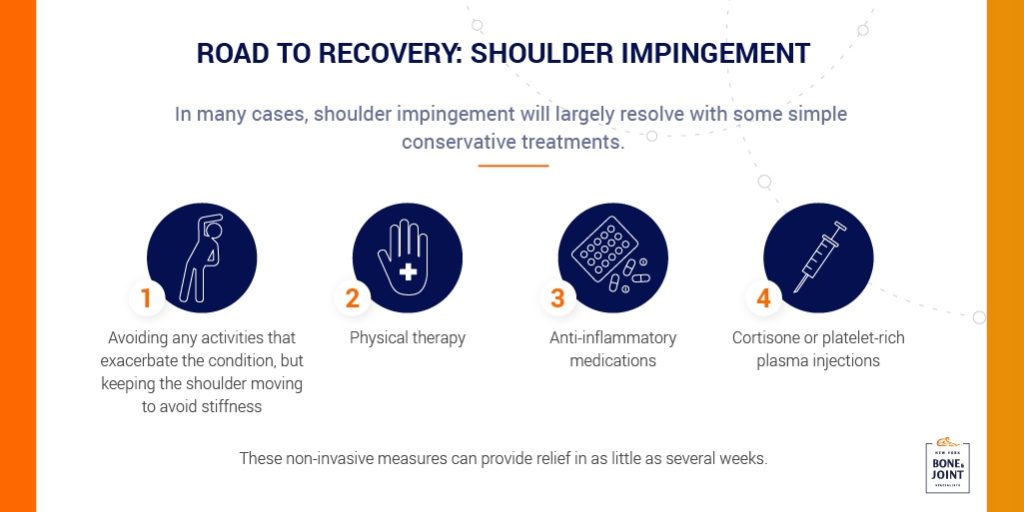Every weekend, New Yorkers head to the city’s parks for a fun game of softball (weather permitting, of course). But for some, throwing a ball or reaching overhead to make that catch brings sharp pain. Other New Yorkers lie awake at night with a dull shoulder ache. Not exactly what you want in a city that never sleeps.
If this sounds familiar, you’re probably dealing with shoulder impingement syndrome. This condition causes over half of all shoulder complaints, but here’s the good news: it’s very treatable.
The shoulder impingement specialists at New York Bone & Joint Specialists can help you get back in the game. We use proven conservative treatments, including targeted exercises that effectively relieve pain and restore function. Surgery is rarely needed for shoulder impingement, but when it is, our orthopedists are experts in minimally invasive arthroscopic procedures that’ll have you throwing fastballs pain-free as quickly as possible.
Understanding Shoulder Impingement: What’s Happening in Your Shoulder
Your shoulder is a complex network of bones, tendons, and a small fluid-filled sac called a bursa that cushions the area between your tendons and shoulder blade. The upper arm bone (humerus) has a ball that fits into your shoulder blade (scapula), while your collarbone is called the clavicle.
Four tendons collectively called the rotator cuff connect your upper arm to your shoulder blade, giving your joint its amazing range of motion. When you lift your arm, your rotator cuff makes it possible. These tendons exist in a very narrow tunnel between your upper arm and the top section of your shoulder blade (called the acromion). This tight space is known as the subacromial space.
In a healthy shoulder, your rotator cuff tendons glide smoothly through this narrow channel. But when that space becomes even more restricted due to inflamed tendons (tendonitis), an irritated bursa (bursitis), or a bone spur, shoulder movement becomes painful and limited.
Shoulder Impingement Symptoms
Shoulder impingement symptoms get worse over time, making daily activities, rest, and exercise increasingly painful and difficult. You might experience:
- A dull ache at the front or side of your shoulder
- Sharp pain when reaching, lifting, or extending your arm overhead (like washing your hair, getting dressed, or throwing a ball)
- Pain that gets worse when you sleep on the affected shoulder
- General weakness in your shoulder muscles
- Pain that travels down your upper arm
- Difficulty reaching behind your back
One of our shoulder specialists will use the Hawkins-Kennedy test to diagnose your condition and rule out other potential causes. Here’s how it works:
- You’ll sit or stand
- Our specialist will help position your shoulder at a 90-degree angle
- You’ll then rotate your arm
- Pain with this movement indicates shoulder impingement
What Causes Shoulder Impingement?
Shoulder impingement is typically an overuse injury caused by repeated overhead arm movements that stress your rotator cuff tendons. Athletes face the highest risk, particularly swimmers and baseball, volleyball, and tennis players who constantly throw, reach up to hit balls, and swing rackets. New Yorkers who lift weights can also develop this growing shoulder ache.
Construction workers, painters, wallpaper hangers, and window washers also have an increased risk because their jobs require regular overhead reaching. Shoulder impingement typically affects people between the ages of 40 and 65. Sometimes a fall or shoulder trauma can trigger the condition, and some people are born with a narrow or unusually shaped acromion.
How We Diagnose Shoulder Impingement
Don’t wait to address shoulder impingement symptoms. Without treatment, your shoulder will become increasingly stiff, making simple tasks like reaching for something on a shelf nearly impossible. Sleep will continue to be disrupted by persistent pain, and you risk more serious injury, like a tendon tear.
At the first signs of shoulder pain, see one of our orthopedists at New York Bone & Joint Specialists. We’ll conduct a physical exam to assess your range of motion and shoulder tenderness. We may also recommend imaging tests like X-rays or MRIs to get a detailed look at your shoulder joints and tendons, checking for bone spurs and ruling out other conditions like rotator cuff tears or arthritis.

Shoulder Impingement Treatment Options
We start with conservative treatments that often provide excellent results. Rest and avoiding activities that aggravate your shoulder can immediately reduce discomfort. At-home remedies like icing your shoulder and taking over-the-counter anti-inflammatory medications can further reduce pain and swelling. Until you find relief, sleep on your back or stomach, or on your unaffected side.
Physical therapy exercises can improve your shoulder’s range of motion and strengthen the surrounding muscles. A physical therapist can also help you correct your posture and find ways to perform tasks without stressing your shoulders. Setting up an ergonomic workstation can be tremendously helpful, too.
Advanced Treatments
Beyond conservative therapies, we offer several advanced treatments for shoulder impingement. A corticosteroid injection directly into the subacromial space reduces inflammation and pain. Platelet-rich plasma (PRP) injections use your own blood to heal damaged tissue and can be very effective for shoulder impingement syndrome.
Shoulder Impingement Exercises: Your Recovery Plan
After about one to two weeks of rest, when you feel less pain, you can begin physical therapy exercises. You should experience gradual improvement in joint function as you progress through the program. Your physical therapist will recommend continuing exercises even after pain subsides to further strengthen your muscles. Complete recovery may take several weeks or months.
Wall Slides (to increase range of motion):
- Stand facing a wall and place a washcloth or small towel in your affected hand
- Start at waist height and slowly slide your hand up the wall as your arm extends overhead
- Go as far as comfortable. Stop if you feel sharp pain. You can work higher as mobility improves
- Hold at the top for 10-15 seconds
- Repeat two to five times
External Rotation (to strengthen rotator cuff muscles):
You’ll need a resistance band for this exercise.
- Secure one end of a resistance band in a door or around a stable support at waist height
- Stand with your affected arm away from the band
- Grab the band with your affected hand and bend your elbow to 90 degrees. Keep your elbow tucked at your side throughout the movement
- With your palm facing up, pull the band out as your hand rotates away from your body
- Return to the starting position
- Do two to three sets of 10-12 repetitions
Pendulum Swings (for mobility and pain reduction):
- Hold onto a table or chair back with your unaffected arm
- Bend forward slightly and let your affected arm hang straight down. This exercise doesn’t use your arm muscles. Use your legs and hips to make your arm swing freely
- Use movement from your hips and legs to guide your arm forward and backward like a pendulum
- Then guide it in circles that start small (about dinner plate size). Make circles larger as pain decreases
- Continue for at least one minute, three times daily
When Surgery Might Be Necessary
Our physicians will only suggest surgery if pain and stiffness persist after physical therapy and other conservative treatments. The surgery is typically done arthroscopically through small incisions with a tiny camera inserted to provide detailed views of your shoulder joint. Using small instruments, this minimally invasive procedure allows the surgeon to decompress the subacromial space by removing bone spurs or damaged bursa tissue, giving your tendons room to move freely.
Shoulder impingement surgery takes two forms:
- Bursectomy: Removing the inflamed portion of the bursa
- Acromioplasty (subacromial decompression): Removing bone spurs on the acromion
Because it’s done arthroscopically, the surgery carries less risk of bleeding, tissue damage, and infection.
Recovery time averages six to eight weeks. You’ll return home immediately after the operation and need to wear a sling for one or two days before beginning physical therapy. Pain should largely subside within two weeks, with complete recovery following six to eight weeks of physical therapy.
Research shows that both conservative therapy and surgery are equally beneficial for treating shoulder impingement syndrome, with shoulder-specific strengthening and flexibility exercises recommended as the most effective initial treatment.
Preventing Shoulder Impingement
To prevent shoulder impingement syndrome, try these strategies:
- Warm up before shoulder exercises and stretch afterward
- Set up your workstation ergonomically with a proper keyboard, mouse placement, and monitor at eye level
- Use an adjustable chair to position your arms at 90-degree angles when typing
- Strengthen the muscles around your shoulder
- Avoid muscle imbalances through proper weight training
- Practice good posture by keeping your head upright and facing forward. Stand with shoulders pulled back and chest out. Don’t slouch
- Cross-train in different activities to prevent overuse injuries
Expert Shoulder Specialists in NYC
Why Choose New York Bone & Joint Specialists:
We understand that New Yorkers live life in the fast lane and want to get back to work and play quickly. Our team is uniquely positioned to help because:
- We’re board-certified orthopedic specialists with advanced training in shoulder conditions
- We use cutting-edge technology and diagnostic techniques for accurate diagnoses
- We focus on conservative therapies with a 90 percent success rate
- We’re skilled orthopedic surgeons when surgery is needed
- We provide comprehensive treatment plans and follow you from initial diagnosis to complete recovery
Ready to Get Relief?
Shoulder pain shouldn’t interfere with your lifestyle. Whether you’re playing sports or simply reaching for that gourmet treat at the store, we’re here to help you safely and painlessly raise your shoulder again.
Schedule a consultation at one of our locations around the city with our online appointment tool.
Frequently Asked Questions: Shoulder Impingement
What kind of doctor treats shoulder impingement?
The orthopedists, orthopedic surgeons, and sports medicine specialists at New York Bone & Joint Specialists have the advanced knowledge and training to treat shoulder impingement pain and stiffness with conservative methods and surgery when necessary. We also have a team of physical therapists to help you achieve full recovery with targeted exercises.
How long does shoulder impingement take to heal?
Conservative treatments can bring relief in as little as several weeks. Recovery from shoulder impingement surgery typically takes six to eight weeks when combined with a physical therapy program. We recommend sticking with physical therapy even after pain subsides to ensure complete healing.
Can shoulder impingement exercises make it worse?
Shoulder impingement exercises are effective for treating pain and mobility problems. A trainer or physical therapist can show you how to perform exercises safely without overtaxing your shoulder. Never exercise when experiencing severe pain. Stop, rest, and ask for guidance from a medical professional.
What’s the difference between shoulder impingement and a rotator cuff tear?
Both conditions cause shoulder pain, but they’re different. A rotator cuff tear is a rupture in one of the rotator cuff tendons, with pain centered in the front of the shoulder. Pain is especially intense when raising your arm.
With impingement, you feel pain in the front and side of your shoulder and the top of your arm. The pain may come and go and increase when using your shoulder or putting weight on it.
Will my shoulder impingement come back after treatment?
It shouldn’t, but you can take steps to prevent recurrence. These include improving your posture, setting up an ergonomic workspace, and keeping your shoulder muscles strong with regular exercises.












